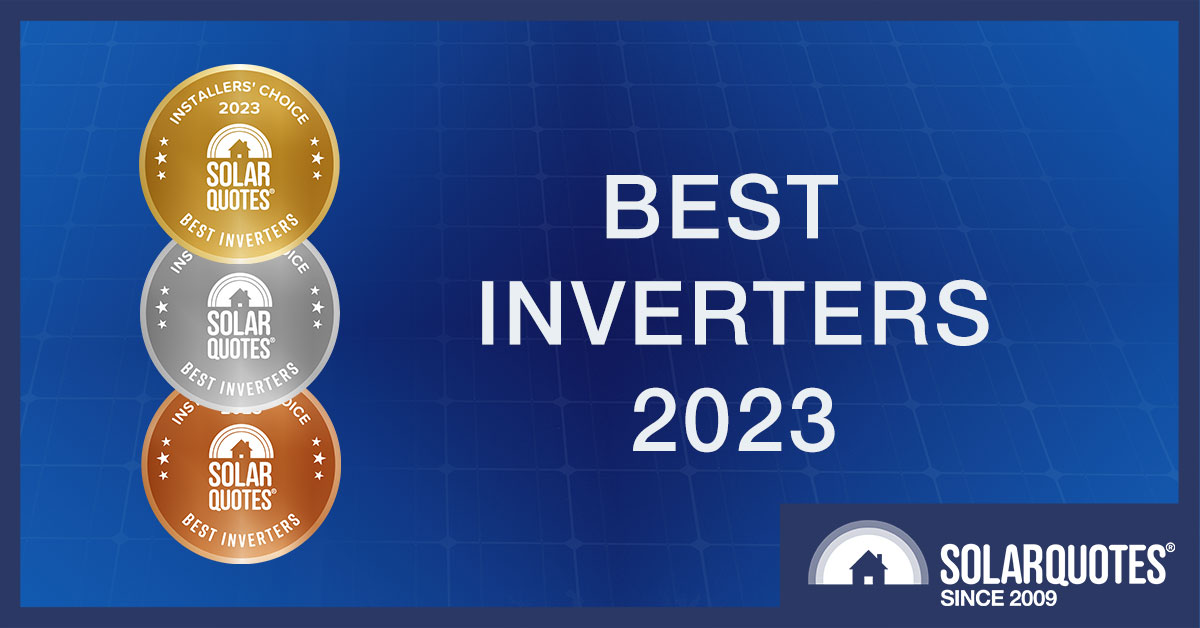
The solar inverter is the hardest working component in your solar energy system. In a well-installed system, it is the component most likely to fail first – well, it is now we’ve got rid of roof-top DC isolators.
But what inverter brands are best?
Every year we ask installers in the SolarQuotes network to vote for the ‘Best Inverter’ and ‘Best Value Inverter’. This year we added a new category: ‘Best Inverter Support’.
Here are the results.
Best Solar Inverters In Australia 2023
Best Inverters 2023 Winner: Fronius
Fronius wins the top spot for the third year in a row with an incredible 48% of all votes cast.
Fronius keeps getting more popular with Australian installers, growing their share of the vote every year:
If you buy a Fronius inverter in Australia in 2023, you will almost certainly be offered their new Gen 24 Model rather than the old ‘SnapINverter’ design – which is getting phased out.
And that’s good news. The Fronius Gen 24 is a worthy successor with two headline benefits:
- It is much quieter. The only problem with the SnapINverter design was how noisy it could get at high power. While the Gen 24 is not silent, I think it is quiet enough not to worry about. I like how Fronius has kept the forced cooling with a fan, as forcing the heat out must be good for the longevity of the electronics, especially in hot Australia.
- All Gen 24 inverters can be upgraded to control a battery with an over-the-air, paid upgrade. This means you can buy the solar-only inverter for about the same price as the old SnapINverter, and if you decide to add a battery later, pay about $1,000 to upgrade. This is cheaper, greener and better than replacing the inverter or adding a second inverter just for the battery. But be aware that your only battery option at present is a BYD battery.
If you want a robust, high-quality inverter with an easy upgrade path to BYD batteries, Fronius is a great choice.
I have a Fronius Primo SnapINverter that has performed faultlessly for five years and counting.
Watch for an in-depth post on the Fronius GEN24 hybrid from our installer-in-residence, Anthony, soon.
Best Inverters 2023: Second Place – Enphase
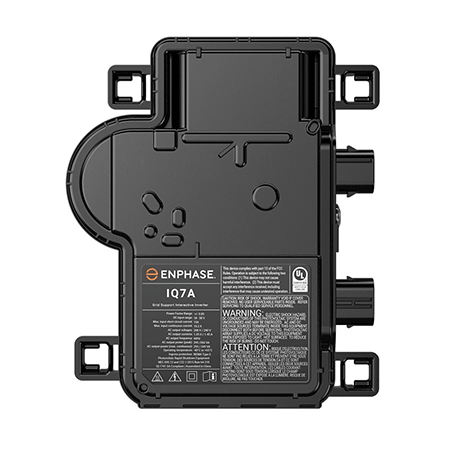
Enphase IQ7A microinverter.
Keeping its second spot from 2022, but with its lowest ever percentage of votes (17.5%), is Enphase.
Enphase makes microinverters, with their current flagship product in Australia being the IQ7A that can work with panels up to 465W.
Enphase’s big advantages for me are:
- The voltage on your roof is kept at 230V AC – no high-voltage DC
- Individual panel monitoring
- Great on complex roofs
- Very reliable microinverter hardware
Their disadvantages are:
- They cost more than a Fronius GEN241.
- The warranty on the Envoy communications box is a stingy 5 years (10 years on microinverters).
- Their monitoring software is awful.
- The company is reportedly a big meanie when allowing third-party access to its APIs. So some of your favourite apps won’t be able to talk directly to your Enphase solar for monitoring, control or curtailment.
I have 35 IQ7As on my roof. I chose Enphase because I don’t want high-voltage DC running through my straw-bale walls2, I like the hardware, and thankfully I can use the Tesla app for monitoring instead of the mediocre Enphase one. One thing that is very frustrating though is I can’t find a third-party app that can curtail the Enphase solar when the wholesale price goes negative. I suspect this is because Enphase HQ reportedly make API access too expensive to be viable for a lot of developers. Hopefully, they’ll change this self-defeating stinginess soon.
Their upcoming IQ8 microinverters, which Enphase claims can run happily without a grid connection or battery, have been imminent for as long as I can remember. The current promise is the second half of 2023 for their Australian release. Let’s see.
Best Inverters 2023: Third Place – SolarEdge
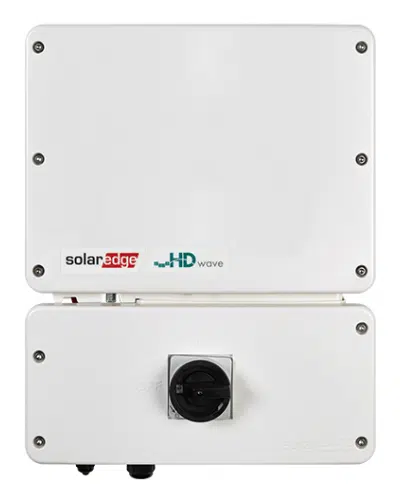
The SolarEdge Energy Hub Inverter. Built-in consumption monitor and can control a SolarEdge battery.
SolarEdge came third despite losing vote share since we started counting. From 28% of votes in 2021, to 17% in 2022 and 13% in 2023. The numbers tell me that more and more Australian installers are moving away from SolarEdge. Funnily enough, many Aussie installers are telling me that too, with frustrations around support and inverter availability in Australia running high recently.
But having said that, 13% of installers in our network are very happy with SolarEdge, and their new EnergyHub inverter with built-in consumption monitoring is a smart move. The 12-year warranty is nice too.
And if you want to upgrade to a battery in the future, then the SolarEdge Energy Hub can happily control the 10 kWh SolarEdge battery with no other hardware required other than an optional backup box.
Best Value Inverters In Australia 2023
If money is tight and you want to reduce the upfront cost of your solar power investment by about $1,000, then you may consider a lower-cost inverter than the three above. We asked the installers which inverter they’d recommend for folks on a budget – here are the results:
Best Value Inverter: First Place – Sungrow
Sungrow takes the top spot for best value inverter for the third year.
Whatever you need, Sungrow makes it: single-phase solar, three-phase solar, and single and three-phase hybrid inverters with full backup.
Their solar inverters come with an industry-standard 10-year warranty – but their hybrids are a disappointing five years.
Reviewers are very happy with the hardware, often less so with the monitoring app. These reviews are from just one week ago:
“The phone app is a bit sketchy at times, poor connectivity, drop outs. The unit itself looks fine and is quiet ”
“The wifi for isolarcloud can not be connected for some reason which is very frustrating. “
If you a looking for a cheap, but not too cheap, solar inverter, Sungrow is a solid choice. If you are looking for a hybrid inverter, the Sungrow hybrids let you use the great value Sungrow battery, with full backup – even on 3-phase.
If you want an alternative to the Sungrow app for monitoring – Solar Analytics can talk to Sungrow inverters without any other hardware required.
Best Value Inverter: Second Place – Fronius
Funnily enough, Fronius do not make a budget inverter. So what’s going on? It’s simply that many installers don’t believe in installing anything other than a Fronius. Many will claim that saving money upfront is a false economy when Fronius is so reliable and well-supported. It’s a strong argument.
Best Value Inverter: Third Place – Goodwe
GoodWe seems to be a hardware maker on the up, developing a solid reputation for good products that are straightforward to set up properly, do what they say on the tin and are a little cheaper than Sungrow.
Recent reviewers generally like the hardware, but as with most budget brands, the app could use some improvement:
“So far, so good. The app gives good information but is basic. Have seen others that provide a bit more detail – this is definitely not a deal breaker though. ”
“This inverter is fine, the monitoring portal is average, it does what it needs to but could be much nicer to use and consume info from. “
The good news is Goodwe is now compatible with Solar Analytics software – so you – if you pay the licence – you can use that for monitoring instead of Goodwe’s app.
One reviewer says his fanless unit makes a lot of noise – which is puzzling – and reported temperature monitoring errors are a worry:
“The inverter (Goodwe GW5000-EH) does make a noise when solar production is high. It is supposed to be fanless and <35dB, however Sunrun + Goodwe have come back to say it seems normal. It does measure at ~45dB but that’s without a sophisticated noise meter. The inverter app also tells me that the inner temperature seems to run from 4 to 7 degrees (yes that’s right) which doesn’t seem correct.”
Goodwe warranties are good, recently increasing to 10 years3 for parts and labour. As with many manufacturers, there are also exclusions on some of the accessories, such as internet dongles, which I think is a rort if you’re supposed to have the internet to maintain the warranty in the first place.
Inverters: Best After-Sales Support
Support is super important with an inverter because it’s the brains of the system; there is a lot to be configured, and most problems down the track will involve the inverter.
Here are the winners:
With Fronius winning again, Australian installers are making a compelling case to install a Fronius, with Sungrow as a great budget option and Enphase if you like microinverters. All three have solid Australian support presence staffed with local, knowledgeable and helpful staff.
See all SolarQuotes recommended solar inverter brands here.
Also check out: SolarQuotes Installers’ Choice Awards 2023 – Best Solar Panels | Best Home Batteries | Best EV Chargers.

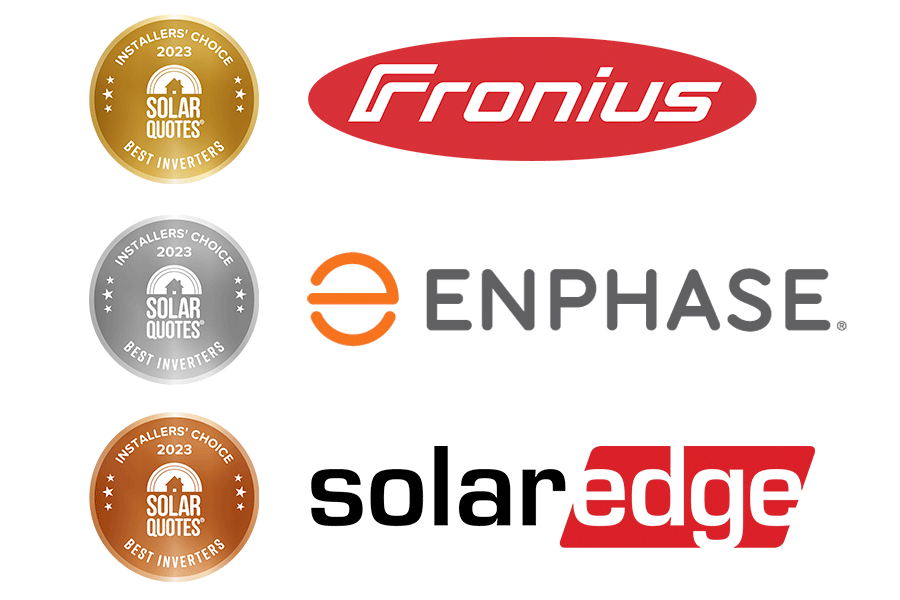
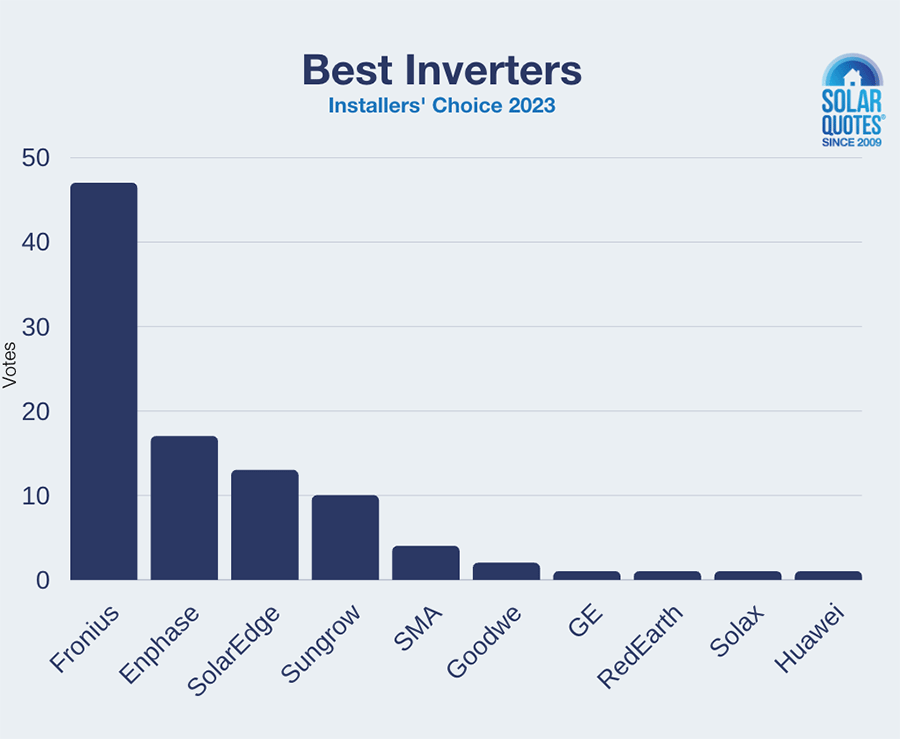
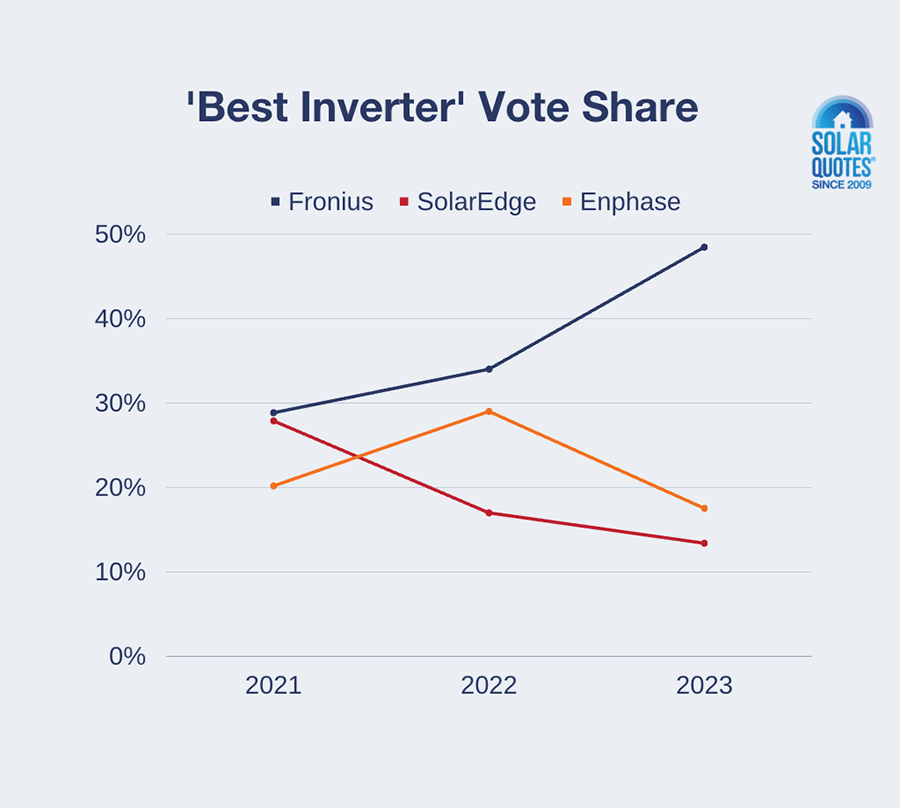
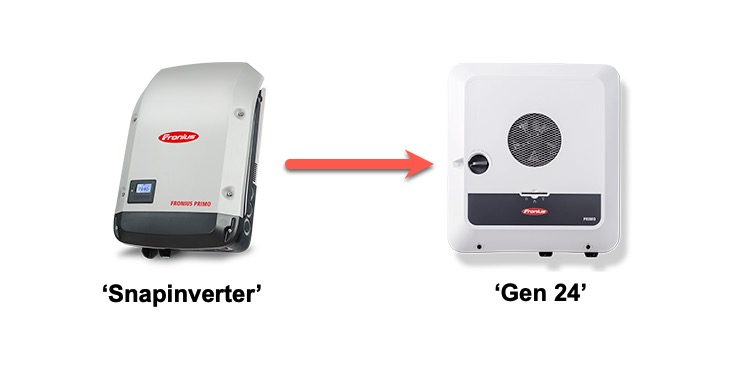
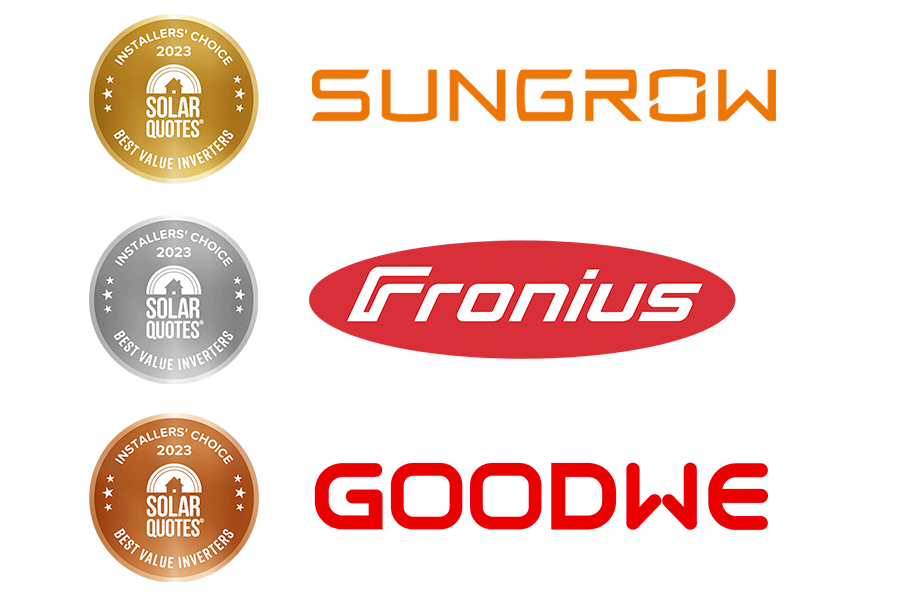
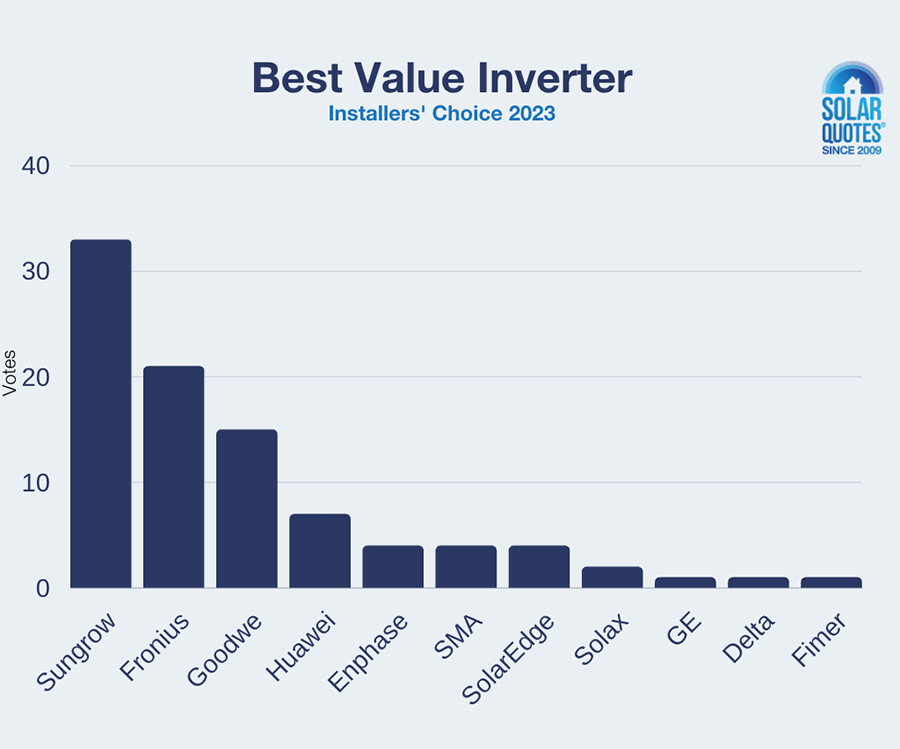
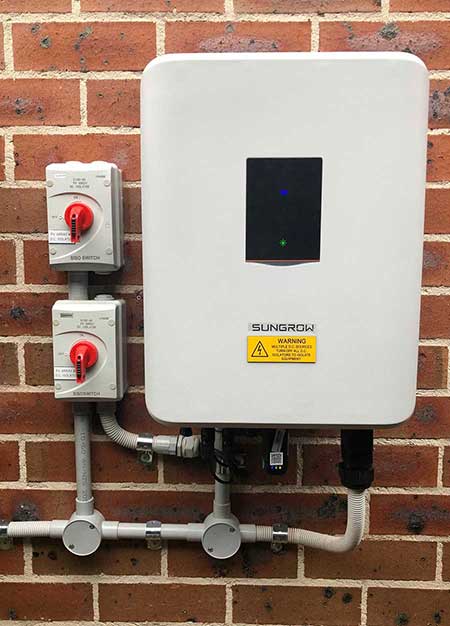
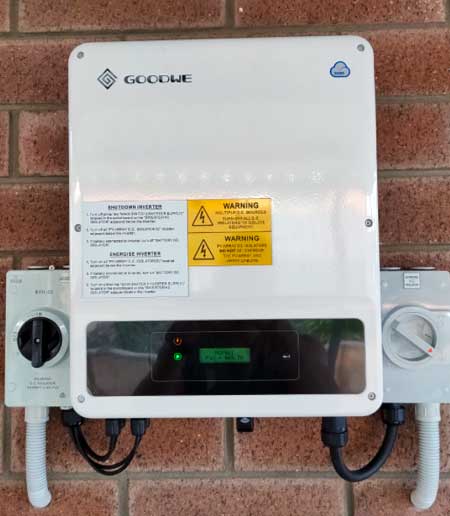
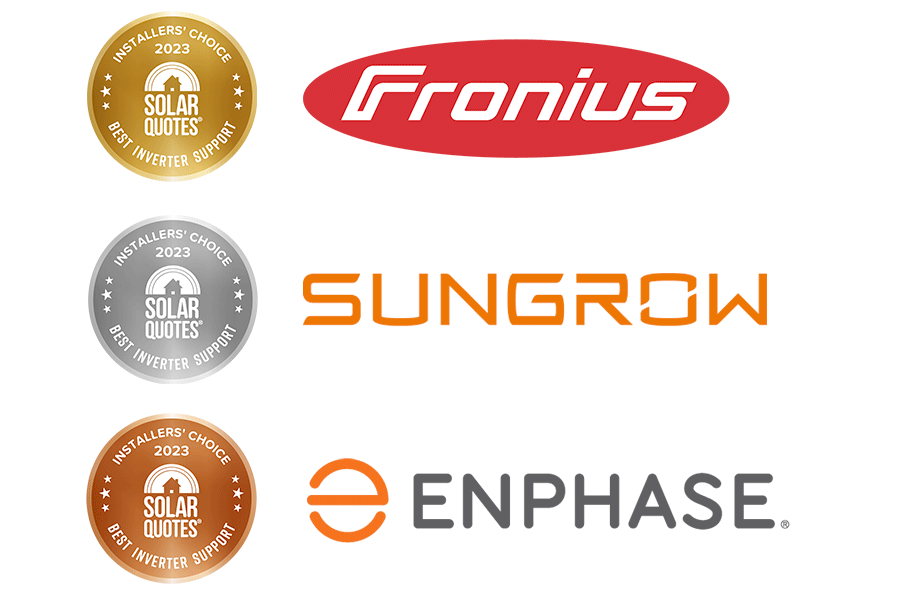
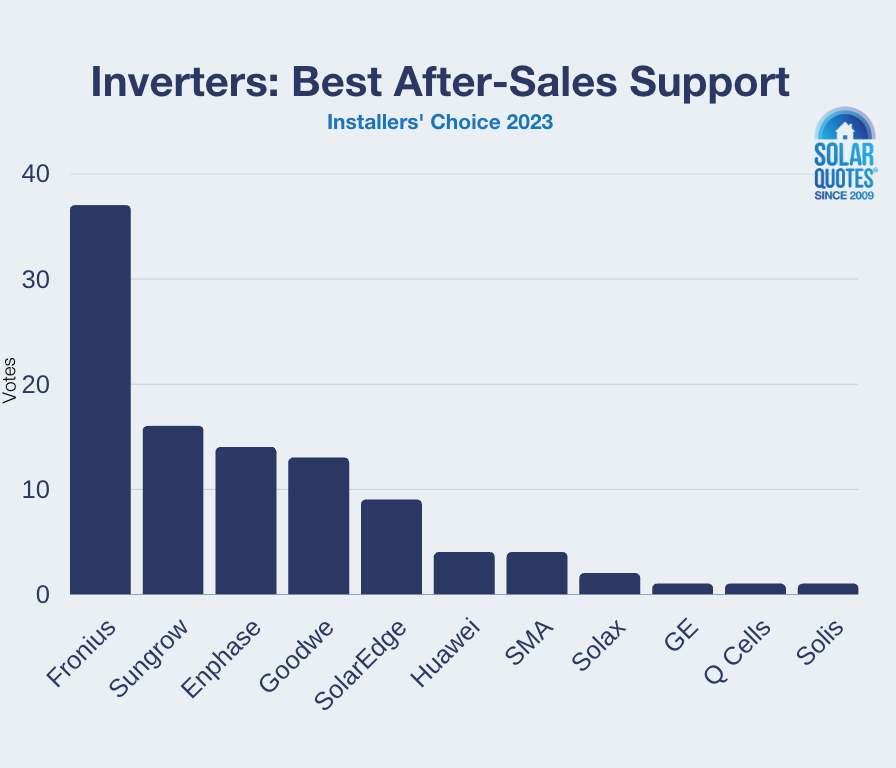
 RSS - Posts
RSS - Posts



Thanks for this, love the reviews. I have Enphase microinverters and a Powerwall 2. Interestingly my installers didn’t even fully hook up the Enphase inverters to the Enphase monitoring software, they said ‘believe us, you’ll want to use the Tesla app instead’. So I can see wattage for each panel, and overall production, but not consumption or exports (from memory). But I get all of that from the excellent Tesla app.
I’m curious, is it possible to mix-and-match batteries from different suppliers? For example can an AC-coupled Powerwall work alongside a DC-coupled battery from another supplier? An inverter question I’m guessing, in terms of managing the final AC current flow to the home and DC to each of the batteries?
It is technically possible to mix and match different batteries and a number of people have done it, but care needs to be taken. If the setup doesn’t have any smarts one battery can end up doing most of the work while the other may sit there doing nothing most of the time. My co-blogger, Anthony, could write about this, as he has worked on more than one multiple battery setup.
Tim
I struggle to understand how the winner is the winner and far better systems like Selectronics do not rate a mention
Perhaps it comes down who supports the designers better rather than what is a better product
Hi Tim
The winners are selected by installers who are doing a lot of residential installations, mostly without batteries. While Selectronics produces brilliant products, they are an extremely small portion of the Australian market and most installers don’t have the pleasure of working with them.
Hi Ronald,
That’s the point I was making below; the installers are concentrating on the better returns for themselves, thanks to the government subsidies. They are not always offering the best or most suitable systems to their clients.
My experience in the quote process was, at best for the unsuccessful bidders, the salesman stabbing around in the dark in an attempt to get me to reveal my budget.
Only by talking at length to a local installer, who was also the approved electrician, could I discuss requirements on my terms. Others were “here are 3 quotes, pick one”. I later discovered my installer is also seconded by the larger solar brands to install systems for their own clients. I’m so glad I bypassed the middle-men.
I too had a preference for the Australian-designed and owned Selectronics, having had a couple of smaller units many years ago, the only pure sine-wave inverter at the time. But my installer was able to present the most suitable tailor-made arrangement after we eliminated all of the design limitations and alternatives, eg, ground-mounted frames, LV cabling through rock, south-facing roof, shading, etc.
But he had offered an off-grid solution with the Selectronics and Fronius combination.
I note too, the Tesla option was also considered, but with 2 units required, and only configurable in series for battery mode, the price wasn’t justifiable for this now ageing technology, although it is still very good. The inbuilt inverters would have also been redundant, needing Sungro or Fronius inverters, only one of either grid-connected due to 5kW limit by Ergon.
All installers should be offering the Australian Selectronic as an option.
That is my point Ronald
They are Australian designed and made and technically superior to this list in my opinion
The point i make is the winner here is the winner for all the wrong reasons
i am also well aware of the 53hz in backup mode issue (and it is a massive issue) which shows these vendors lack of quality design
Hello all.
My take on the votes is that the results are more based on market share of the brands/products -am I correct?
If so it seems to me that what Tim is suggesting makes sense – the awards are not necessarily based on the technical superiority of the product but volume of sales.
Such volume of sales might well be influenced by the marketing of the products to the installers by the offering of good after-sales service etc and, maybe, $ rebates to the installers that the end consumer knows nothing about?
Tim – you mention Selectronics as being a superior brand/product – it seems that its technical superiority, if in fact it is superior, should be compared technically to the other products on the market by some-one like SolarQuotes who seem qualified to do a comparative review and ranking them on this basis.
Are you aware of such a comparative unbiased review?
I, for one, would like to read such a review.
It may be that Fronius comes out on top but we don’t and won’t know without such a comparison – that’s a challenge SolarQuotes!! ???
I’m honestly a bit surprised that SMA performed so poorly in this. My understanding was that it was a tossup between SMA and Fronius for quality, and that SMA had the largest market share.
Is my info out of date, never in date, or SMA are simply popular, just not favoured by installers as best, best value, or best after-sales support?
SMA’s popularity was reduced by their decision to manufacture in China rather than Germany:
https://www.solarquotes.com.au/blog/chinese-vs-german-sma-sunny-boy/
That was only one line of single phase inverters though wasn’t it? Or have they shifted more\all production to China?
It appeared to be related to a decline in their market share. But note that is just my impression.
‘Pop culture solar installers’* whinge that SMA are ‘cheap Chinese’ because they moved just one line of single phase inverters to a SMA owned and run facility on Chinese soil.
And yet all SMA 3-phase, commercial, off-grid and battery inverters are manufactured in Germany or the USA. How come you forgot to mention this Ronald?
Contradictory, the same pop culture solar installers don’t say anything about Enphase, SolarEdge, Sungrow and Goodwe ALL manufacturing ALL of their inverter product models in China.
It really is quite bizzare why people try and link SMA and China when it’s a German company and nearly all of it’s production is in Germany and the USA. And yet all other inverter companies manufacture in China. Except Fronius and SMA.
And when it comes to popularity between SMA and Fronius, based on solar installers around the world, it’s beyond telling when you look up and compare SMA intl shipments vs Fronius intl shipments.
These surveys are based on flavour of the month, not actual technical superiority. For example, Huawei is a far more superior product then Sungrow and Goodwe, in all of Huawei’s capabilities and product offerings.
* I refer to a pop culture solar installer as an installer that just sells based on what everyone else is selling. Not based on results of actual individual testing of all products and not based on actual technical and product eco-system superiority. The industry is mostly made up of pop culture solar installers, just following the current trend.
This pop culture solar expert went off SMA after their Chinese experiment, because I don’t like hypocrites. And boy, I remember how SMA used to claim how much better German manufacturing was – and imply Chinese stuff was crap – right up to the day they bought Zeversolar.
It takes decades to build a brand, and explain what it stands for. If that flips 180 degrees, you can destroy your brand overnight. SMA’s Australian market position went from top-dog to mongrel – because humans are emotional beings. If a brand takes the piss – they’ll vote with their wallets. It’s a case study in how to grasp defeat from the jaws of victory with brand positioning
P.S. I really like SMA inverters these days.
Whilst the Fronius inverters are built to a very high standard, there is at least one glaring shortcoming for a modern solution, that being the switchover time to battery backup – < 90s! When compared with the Sungrow – < 20ms (e.g. within one cycle/seamless/no apparent loss of power) – it comes up well short.
100% agree, the 40-second switchover time is a joke.
This comes down to the fact that Fronius handles backup externally. This is better as it allows you to backup more loads, more easily. Due to the Sungrows inbuilt backup, you have to be very selective about what is connected as you can overload it in normal operation. Ie. You couldn’t backup your kitchen circuit as when you go to cook dinner that night you would overload the inverter even if the grid is present. This wouldn’t be a problem for Fronius. As Fronius handles backup externally, you only have the potential to overload during a power outage. Due to the change over time, you will be aware of the outage and can choose what you use during that time to avoid doing so.
Other feedback I have received is that the changeover time is useful as it makes the owner aware there is a power outage so they can shift their habits to preserve the battery for as long as possible. A UPS backup means you likely won’t know of the outage, continuing your normal behaviour and potentially draining the battery quickly.
I understand there are cases in the real world where someone may need a UPS specifically, however this is typically in business cases not a residential installation scenario.
I’d be raging if I spent thousands for blackout protection yet still had to reset the clock on the microwave and the oven if the power dipped out.
Whilst I can understand it would be frustrating is resetting clocks really a game changer compared running down battery too quickly? (Householder trying to get a handle on which system to buy)
SolarEdge is similar, except the switchover outage is more like 5 seconds than 40. Needless to say this was portrayed as a feature (you likely know there’s a blackout) rather than a problem! And you get the fun of resetting a bunch of clocks…
I run a couple of computer fans with a smart plug timer on the top of my Goodwe unit for good measure even though it’s passively cooled, moving some air over the rear fins can’t hurt.
Do the same with my Sungrow. 6 computer fans on a timer, dropped the temperature > 20 degrees.
Can you please mention the inverter size and the size/CFM of the boxer fans?
Am noting temps well over 70 Deg on Sungrow 10 kWh inverter during spring in Qld!
Way too hot.
Great idea ?
The Sungrow inverter pictured looks exactly like my 2018 Solax. Are the companies related?
Solax still has screens on their inverters while similar looking Sungrow inverters are screenless, so I don’t think there is any chance of one making inverters for the other.
I disagree with the comment “I like how Fronius has kept the forced cooling with a fan”. I’d like a Fronius inverter when I upgrade my system but am put off because fans are a weakness. I had my small solar system installed in 2010 and the Australian made inverter had a fan which was the main point of failure. Luckily the first failure was during the “Parts and Labour” warranty, but subsequent fan failures were out of warranty and expensive to repair.
As a electronic engineer I understand the advantages of keeping the electronics cooler and fans are great in very clean air environment. However even the cleanest garages are dusty and fans operating long hours tend to suck in lots of dust which builds up causing problems, and the fan itself is prone to eventually fail.
As far a I can see the second 5 years of the Fronius warranty is “Parts Only”, and the labour to replace the fan will be expensive.
You are right. Very smart. I still think SMA inverters are still the best.
SunGrow Hybrids won’t do whole house back-up, well they might if your house pulls less than 25amps and have a big battery. They have a back-up circuit (EPS) that gets wired to specific or specified circuits, and generally no large loads like pumps or big air-cons.
Hello Finn,
Probably Fronius is the most installed but does this make it the best on the market? As you mentioned there are different factors to consider such as availability of other inverters and probably some perks the Company gives to the installers?? I am not sure how it works in this industry but I am sure there will be incentives to push for the use of specific product.
Please, don’t get me wrong I had three Fronius inverters and 6 months ago I moved to GEN 24 with BYD battery. In the past we had the Symo Hybrid and Symo. Yes the Symo were a bit noisy but for 6-7 years they did not miss a beat. The issues I found with GEN 24 was that if the power goes off the Gen 24 goes in protective mode. Last time lasted 4 hours and we could not use the battery. The other annoying issue is the 40- 45 sec delay to switch to battery mode. Noise level is not of any concern..and yes the support from Fronius is on another level. The guys tried everything to resolve any issues I had, even weekends. If I have to pick an inverter, I’ll still go with Fronius and mainly because the reliable support they provide.
Fronius might be good quality hardware but their software is absolutely horrid to put it nicely. Trying to navigate their apps both online and mobile is just pathetic. It hard to believe a company like this is can put out such cr#p.
The noise issue is just ridiculous, if I’d know it was that bad I would never have bought one, it’s that bad. Sounds like a jet aircraft my garage, these pieces of cr#p should only be installed outside.
Older Fronius inverters could be quite noisy so placement was very important. Fortunately, the current GEN24 inverters are far quieter so it’s much less of an issue.
And yet.. we operate this small research station using a Trace/Xantrex 3024 20 years old (and hopefully it will run for another 10 years), and it was a rescue unit. Few bells and whistles, no web connect, it just does the job.
Spoiler alert – it lives in an enclosed room – no critters and warm and dry – essential in the wet tropics where electronic equipment goes to die. We monitor battery state with a Trimetric 2020 and a second Xantrex acts as the charger. Plus if it fails,we can usually fix it.
The Fronius can be set to deliver a 12VDC signal once production reaches a certain user-defined wattage, like 2,400W for the HW element. The period can also be set and as after 3PM I get a very generous 10c/kWh here in WA, I drop the 12V to zero via Fronius software. A 40A SSR (Solid State Relay) in the HW circuit responds to this signal is used to produce hot water when the production is sufficient.
The Solar.web app allows the Fronius to be configured via WiFi and solar production is available on the mobile in real time.
That user-defined “surplus PV” output is very interesting. For my (still) pending off-grid install, I’m looking at two 10 kWp arrays, with a pair of 5 kW Fronius inverters on one, two Victron Multiplus 5000/70 and a 30 kWh battery on the other. The Victrons can throttle the solar inverters with frequency shifting. A Jackal or ACthor power diverter can also sense that for HWS power management, but at much higher cost than a simple SSR driven by your output. It just doesn’t pick up surplus solar from the MPPTs feeding the battery & Victrons – unless the output takes throttling into account?
I’m also keen that an EVSE will normally only take surplus PV for EV charging, and am looking at Victron’s smart EVSE for that, but it appears to be expensive. Especially off-grid, prioritising energy flow is important. It is not acceptable to discharge the house battery for HW or EV, just because of clouds.
The Youtube clips of Victron monitoring and configuration look very good, and the apparent requirement for a cloud connection might also be a battery warranty requirement anyway. There’s even compatible open source monitoring software running on a Raspberry Pi. (What more could a Linux nut wish for?)
Incidentally, REC Alpha Pure PV panels are claimed lead free. As my only water supply comes off those roofs, that sounds good. But other panels would only have lead underneath, inside the junction box, I wonder? (The REC form factor doesn’t fit as well as Tindo Karra 405W.)
The 20 kWp of PV is only 6 or 7 kW in winter or overcast, so no overkill, I figure. Now if cheaper Na-Ion batteries could hit the market soon, star alignment would be superb.
The amount of lead water will pick up from an intact solar panels should be zero. Even if the panel was broken into pieces the amount of lead contamination from it should be tiny. One figure I’ve seen that I’d like to have confirmed is there’s less than a gram of lead in a modern panel.
With my recent new install, I wanted Fronius and Solar Analytics but got talked out of it due to the sales blurb about how Goodwe was the way to go with their own wifi kit etc. I should have stuck to what I wanted and not what they wanted to sell me.
Interestingly I have since contacted Solar Analytics but have not even had a reply from them, perhaps the GW15KAU-DT kit is not compatible?
Hi John
Unfortunately, integrated Solar Analytics does not appear to work with your DT Goodwe inverter. Here are the compatible models.
https://info.solaranalytics.com/s/article/Goodwe-with-Solar-Analytics-Overview
But your system will support a “classic” unintegrated setup and Solar Analytics should have gotten in touch with you. It may be a good idea to contact them again.
Hi Ronald,
Thanks for the reply.
I have just done more reading on the “Classic” setup and it mentions a “Wattwatchers smart monitoring” installation if my understanding is correct. Would you know roughly what sort of price I would be looking at for this?
Classic Solar Analytics might set you back around $500. If you scroll down a little on this page you’ll see some information on Solar Analytics:
https://support.solarquotes.com.au/hc/en-us/articles/115001271874-What-third-party-energy-monitoring-solution-should-I-buy-
For systems of 15kW or less, the monitoring subscription fee can be $250 for the first five years. Here’s a link to Solar Analytics subscription fees page:
https://www.solaranalytics.com.au/subscription-prices
I understand the Fronius GEN24 can now also use LG RESU Flex Batteries but not sure if these are currently available in Australia.
The Fronius GEN24 datasheet says they can be used with LF RESU Flex batteries, but I don’t know of any installations using them in Australia.
Gents,
You don’t mention battery compatibility with enphase?
What batteries are compatible with my enphase iq7+ micros and associated controller, I have 29 of them.
Hi David
Enphase microinverters are compatible with AC coupled batteries, as they work with any inverter arrangement. The most well known AC coupled battery is the Tesla Powerwall 2. Fortunately, there are plenty of other options as that’s a little expensive at the moment. Enphase’s new battery is also AC coupled and, of course, compatible. Unfortunately. it’s not clear when it will be available in Australia, but some people in the US like it and say it beats a Powerwall 2. But, of course, opinions differ.
Here’s our help page on getting batteries with microinverters:
https://support.solarquotes.com.au/hc/en-us/articles/115002102314-Can-I-add-batteries-to-a-microinverter-based-solar-system-
And here’s our battery comparison page which shows which battery systems are AC coupled:
https://www.solarquotes.com.au/battery-storage/comparison-table/
My Solaredge 3 phase inverter hasn’t missed a beat since the installer had to swap it out for the problematic 2 phase inverter which was always going to have voltage problems, and did from day one. If it lasts the distance I’ll be happy with it. So far so good.
On that note the old SunnyBoy, think Rudd era, is also still pumping out energy from the 2 kW system installed. Talking about 16 years ago now. Impressive.
I’m on the hustings for another system on another property. Will take note of suggestions. The Fronius is an Austrian inveter from memory (?), so one would expect it to be good. Will likely go that way on a 6.6 kW system with no battery. Hope the forum agrees with the choice. Now need to decide on panels. The LG panels complementing my Solaredge inverter have also worked perfectly, so far, but not sure I want to spend as much on the next project. Suggestions?
Thanks to all.
Hey Finn,
Fronius is not forthcoming with all relevant information on their hybrid Gen24. In back-up mode, it runs at 53Hz not 50Hz.
While many devices can deal with the disparity (modern inverter fridges and air-cons) there are many others that do not perform well, if at all.
I have had to replace a microwave oven, the spare TV has popped its power supply, my bar fridge compressor has failed and I’m reluctant to use my Weston Time Machine valve amplifier until such time I have confidence in the reliability of the supply.
When on battery supply, the Breville coffee machine has a 2-stage pressure pump, the lower pressure not working at all on 53Hz, the 2nd stage you can hear racing and the associated valving doesn’t have time to open and close properly.
The swimming pool pump has it’s own 3-speed frequency control which normally runs high speed for the first 5 mins of power supply before switching to low speed. On battery back-up supply, it short-cycles on and off 10 seconds at a time so I must be mindful to switch it off to prevent it burning out.
We have many power outages in this area and I am suspicious of spurious voltage spikes on changeover: The battery back-up mode doesn’t deploy until 40 seconds of grid power loss, allowing Ergon’s automated 3 x 10-second attempts at closing their own supply breaker. So All power is off for this 40 seconds.
When grid power resumes, it is virtually instantaneous on changing back to normal supply, only the Cel-fi mobile phone booster light and electric oven beeping as to the interruption.
As for the 53Hz business, Fronius state it is to prevent another grid-connected inverter from paralleling and supplying power back to the grid. Which is preposterous to state if the grid has failed.
They state it cannot be adjusted which I find is more like they have no authority to change it.
System: 14.8kW REC Alpha, 2 x Gen24 Primo’s in master mode 50/50 split board, 22kWh BYD storage.
NB: the Sungro hybrid runs 50Hz in backup mode
You have raised a good point. When getting a Fronius GEN24 PLUS and a battery, it’s important to confirm that any devices that will be run off backup power won’t be adversely affected by being operated at 53 Hertz. The SMA Sunny Island systems also run at 53 Hertz, so people with experience with them should have some insight into the issue.
UPDATE: Actually, the Sunny Island runs backup at 52 hertz.
Hi Ronald,
I called Ergon, they are required to supply 50Hz ± 1.0Hz, and the variation from 50Hz removed within 4 or 5 seconds. From AEMO website for DNSP’s:
“…a generating system must be capable of setting the deadband and droop within the following ranges:
(i)the deadband referred to in subparagraph (1) must be set within the range of 0 to ± 1.0 Hz. Different deadband settings may be applied for a rise or fall in the frequency of the power system as measured at the connection point; and
(ii)the droop must be set within the range of 2% to 10%, or such other settings as agreed with the Network Service Provider and AEMO;
The only power supply that is a steady 53Hz is the Gen24 series in back-up mode: From Fronius’ Application Guide for Gen24:
“…and AC frequency set at 53 Hz. AC frequency is purposely increased with the intention of disconnecting other inverters connected to the backup circuit if any.”
I wanted to ad more even though it is within character limit, it won’t let me.
If suppliers of electrical components like white-goods, tv’s, etc. must comply with the grid supply parameters, surely alternative power supplies such as battery-powered house inverters must be compatible to the products within the house? Fronius’ responses to me claiming my equipment should be able to handle the 53Hz is simply not good enough.
Before I purchased this esoteric system, I was disappointed to learn that the default 6kW systems are pushed onto unwitting clients who are trying to do the right thing. I asked “what happens when the grid fails, do the panels then supply the house load?” No was the answer, you need a hybrid.
Also, I was asked “what circuits do you want on back-up?” “All of them” I said. I shall determine the necessity of an A/C running overnight or the dishwasher or oven requirements after dark.
If I went with the initial suggested systems. I would be very disappointed.
Don’t get me wrong, this is now very nearly a perfect set-up but for the 53Hz issue. I can push more than 10.3kW grid connected and 9kW in back-up (if I wanted to). It is a very good system.
The grid has strict limits on frequency. I don’t know what the requirements are for off-grid backup, but I know who to talk to.
Thanks Ronald, please send me an email. I would dearly love to simply have the back-up supply within Australian Standards.
BTW, I have a SwitchDin Droplet for comms and controlling standard inverter parameters. The 2 x 11kW BYD banks work in unison during grid connection.
Well, I mentioned this to Anthony and he said a battery providing backup power at 53 hertz does not violate any regulations or guidelines he is aware of, provided it is for off-grid backup. But this will cause problems for any other solar inverters present, as they will detect the rising frequency and shutdown. So it is an obvious issue for some setups.
He sent me this link on how the SMA Frequency-Shift Power Control works, in case you’re interested:
https://www.sma-sunny.com/wp-content/uploads/2016/12/SB-OffGrid-TI-en-42.pdf
Ronald, frequency shift power control is a standard way for a battery inverter to throttle back a solar inverter when the battery is approaching full charge and AC loads are not soaking up the surplus PV generation. Power diverters such as ACthor also interpret frequency rise as surplus PV availablility, and shuffle some of it off to water heating. For it to work well across brands, e.g. Fronius and Victron, compatible firmware must be confirmed, AIUI. (I suspect that the Victron smart EVSE uses a data link instead, to know when to divert surplus PV to the EV.
It surprises me that a 6% frequency shift mucks up some devices, as TVs and even videotape players have for decades worked fine off our off-grid petrol generator, which is unlikely to ever be within that spec. Heck, the TV even soldiers on when the generator starts surging wildly in revs as the fuel runs out. The lights surge drunkenly, but the TV is immune.
As an inverter aircon must rectify the AC before generating its own AC frequency to modulate motor speed, one would expect that 10 or 20% input frequency variation ought not be noticed at all. I have heard of LED lights flickering, though.
Note that some equipment is marked 100 – 240v 50/60 Hz, declaring tolerance of +20% frequency variation. The dodgy stuff experienced seems substandard. I will be checking out any new fridge/freezer, though, after hearing of the dodgy fragile products.
What do they say? Off-grid is not for wimps?
Probably that is why my Gen24 shuts down after the Grid Power is restored. Fronius thought it was overload but I was wondering if this was correct. It would be interesting if other Gen24 users are having similar issue?
Hi Ilian and Erik
I posted another response to my posts above but they decided to not show it. I’m not sure for what reason, it had more information.
I guess solarquotes is entitled to censure anything that they may deem as counter to their business, but I don’t think it is very democratic. I thought relevant information can only assist the industry.
I cannot reply to any of the relevant posts either. “Put down your weapons”? Why would you need to state this?
Ilian, My Gen24’s were also shutting down in the early days.I can only suggest contacting your installer and Fronius. You will find they work together to resolve the problem. But they need to know the problem exists first. Don’t assume it has resolved itself without some intervention. They have access to historical data, try to give them a time-frame for when it tripped.
Erik, I suspect possible damage to my various devices is more due voltage spikes at grid loss. But I can’t yet rule out 53 Hz in backup mode. It seems to be an unusually high number of product failures since installing my system. Don’t get me wrong, it’s still a very good system; After 6 months the installer called and had been on the blower to Fronius the whole day. They arrived at a rewiring the house solution to try, but it also involved purchase of another 2 Fronius Smartmeters at an extra $500 (it’s complicated!) at my expense. They also offered a cheaper alternative but that was a false economy to me. Having agreed that this system was delving into unknowns at the beginning, the installer asked me to work with him.
Fronius gave me the vanilla reply I expected, telling me the 50-60 compatibility of my own equipment. I have a video of the coffee machine, pool pump and new microwave operating in both modes. 53Hz does not allow these devices to function properly. I have 6 Mitsubishi split-cycle A/C’s only run for daytime (the b/r one on a few nights on humidity control) an LG smart fridge, 9 ceiling fans, large septic tank, 24hrs no prob.
Equipment sensitivities can be a puzzle until diagnosed. My brother found his Victron Multiplus II battery inverter would not accept generator input from his nifty little Aldi generator. He answered “yes” when I asked if it was an inverter generator, as quite a few little modern units are. So first we tried a mains interference filter of sufficient current rating. The inverter still took minutes to accept power, then quickly dropped out. Plan B was to buy an old fashioned generator (no inverter). Problem gone – instant acceptance of input power. That rather proved that the harmonics in the inverter output upset the Multiplus, i.e. the inverter on the generator did not synthesise a sufficiently clean sinewave for the two to get along.
It’s another case of off-grid power needing compatible system components. Until your issues, I hadn’t considered domestic gadgets being a possible weak link. Other people’s experience can be an eye opener.
There are other ways than frequency shifting to throttle a PV inverter, but it is a heck of a lot cheaper, and less ripping out of equipment, to swap out the coffee machine, I figure. Best of luck with wrangling a solution.
Sir, i need a book on solar installations – etc
The excellent news is we have a book for you. The Good Solar Guide:
https://www.solarquotes.com.au/good-solar-guide/
You can buy a physical or electronic copy – which will be good for Finn’s ego – or you can go to the above link and read it for free. Finn thinks it’s more important for people to have easy access to good information than for him to make a few dollars on book sales.
I have solar panels with Enphase inverters, no battery as yet. I plan to expand system for an EV, would like V2H, & V2G capability when it is approved. What battery, app and management software would work well with the Enphase setup?
Geoff Price
Charles says
I am thinking of getting a 10K Huawei hybrid inverter with 2 Huawei batteries. Problem is there is not much anecdotal evidence on Huawai Solar.Wonder if anyone is ready to share their experience.
Thanks
Charles